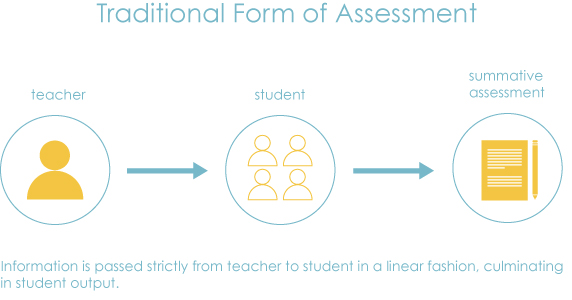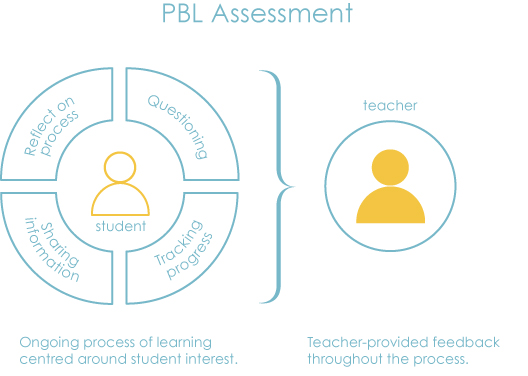Assessment of Passion-Based Projects
The main difference between assessment of PBL projects and traditional methods is what part of the learning is focused on. Traditionally, students are asked to show their learning of content that has been chosen by the teacher in a culminative way, usually in a paper-and-pencil format, such as a test or worksheet. In contrast, PBL assessment is ongoing and is completely focussed on the performance and progress that students have made by the end of their project (Norton, 2011).This type of assessment depends on what students have set out to learn and will be unique to each individual student.
Traditional Forms of Assessment vs. PBL Assessment
Assessment tools to use in Passion-based learning projects:
Assessment is an ongoing process in passion-based learning. Here are some examples tools a teacher may want to use during assessment throughout the PBL project timeline:
Before project begins:
PBL project outline/organizer: students will fill in information relating to:
*Teachers should provide feedback to the student regardless of whether their topic is approved or not.
During project:
Student reflections: reflections are probably the most critical part of PBL assessment. Reflections allow both teachers and students a look into the interpretations, struggles, achievements and connections that students have made while learning about their topic. This is also a way for teachers to assess whether students are still on the right path in terms of what they set out to learn or whether they are missing the mark and need some gentle redirection.
After project completion:
E-portfolios: A space where students can show evidence of their learning and reflect on the knowledge and skills that they have gained. E-portfolios can be tied into the reflective pieces described above and should be added to throughout the entire project timeline. Examples of student e-portfolios can be found on the “Student examples” page.
Benefits of ongoing assessment:
One last note…
Although grading is dependant on individual teaching philosophies, it is advised that descriptive/constructive anecdotal feedback and performance focused rubric scales (4 = powerful understanding; 3 = good understanding; 2 = developing understanding; 1 = emerging understanding) be used rather than numerical scores. In this way, the focus is on the learning process and not on whether the student’s conclusions were “right” or “wrong”. (Young, 2009).
Assessment is an ongoing process in passion-based learning. Here are some examples tools a teacher may want to use during assessment throughout the PBL project timeline:
Before project begins:
PBL project outline/organizer: students will fill in information relating to:
- the topic they are interested in learning about.
- key questions that they will be answering.
- projected timeline of what will be accomplished in terms of research and goals.
- ideas on how they will present their learning.
*Teachers should provide feedback to the student regardless of whether their topic is approved or not.
During project:
Student reflections: reflections are probably the most critical part of PBL assessment. Reflections allow both teachers and students a look into the interpretations, struggles, achievements and connections that students have made while learning about their topic. This is also a way for teachers to assess whether students are still on the right path in terms of what they set out to learn or whether they are missing the mark and need some gentle redirection.
After project completion:
E-portfolios: A space where students can show evidence of their learning and reflect on the knowledge and skills that they have gained. E-portfolios can be tied into the reflective pieces described above and should be added to throughout the entire project timeline. Examples of student e-portfolios can be found on the “Student examples” page.
Benefits of ongoing assessment:
- Allows for teachers to provide necessary feedback throughout the learning process where necessary.
- Creates a much richer and rounder picture of how students have progressed in their learning from the beginning of the project to the end.
- Allows students to realize and grow from their “mistakes” and redirect their own learning without being penalized (Black et al., 2007).
One last note…
Although grading is dependant on individual teaching philosophies, it is advised that descriptive/constructive anecdotal feedback and performance focused rubric scales (4 = powerful understanding; 3 = good understanding; 2 = developing understanding; 1 = emerging understanding) be used rather than numerical scores. In this way, the focus is on the learning process and not on whether the student’s conclusions were “right” or “wrong”. (Young, 2009).


